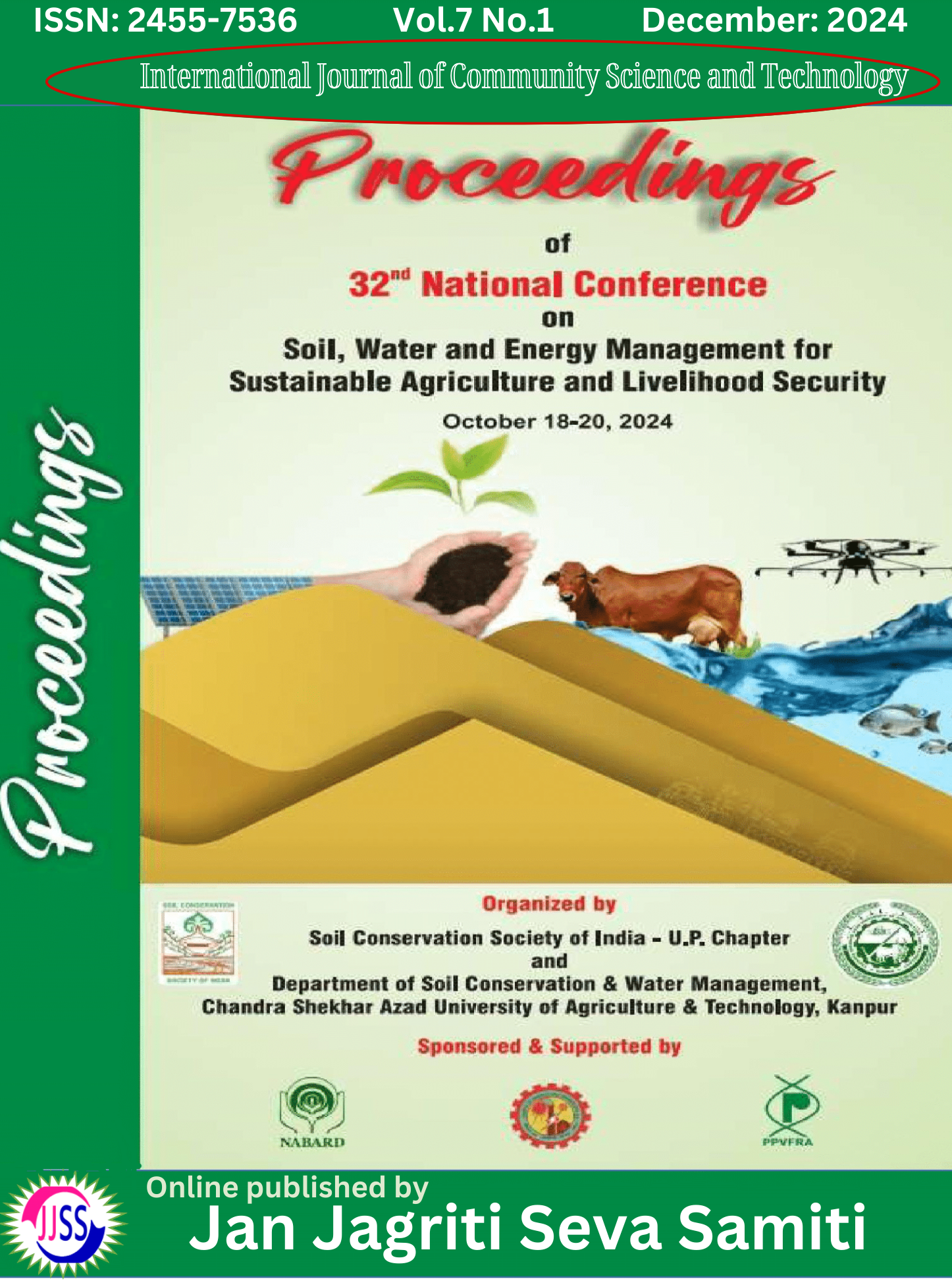EVALUATION AND IMPACT ASSESSMENT OF WATERSHED MANAGEMENT PROGRAMME ON NATURAL RESOURCES IN SURDI WATERSHED AREA
Keywords:
WATERSHED MANAGEMENTAbstract
Water is a precious natural resource which is essential for life on the earth. The relentless increase in the demand of water for various purposes brought about by the population growth, agricultural and economic development combined with increasing pollution of water supplies, have created water scarcity problems. The challenge, therefore, is to improve rural livelihoods through efficient and sustainable rainwater management technologies for increasing rain-fed productivity and thereby contribute to food and livelihood security. In India out of 329 Mha of geographical area nearly 50% land is said to be either waste of degraded nearly the land water and natural vegetation resources of for country area under tremendous pressure droughts floods and other climatologically extremes are common phenomenon in one or the other parts of the country. In the last 125 years the country has experienced 25 droughts when more than 70 percent area was affected in the last 50 year, the country has experienced more than 14 droughts of which 1987 drought was the worst, affecting almost half of land of country (Anonymous, 2000). Arid and semiarid regions of India are more prone to drought than the other climatic zones, the probability of drought being 20 percent of the years often the drought persists continuously for 3 to 6 years. Under such a scenario, the challenge is to manage land and water resources in a sustainable manner to achieve higher productivity levels, maintain resources for future generations and derive livelihoods in the most equitable manner possible. Watershed management has emerged as the cornerstone of rural development in the dry and semi-arid regions and other rainfed regions of the world. The watershed is the appropriate hydrological unit for technical efforts to manage water and soil resources for production and conservation. Watershed management programme would permit maximum possible stability through the process of production, consumption and regeneration. This approach has become the key for improvement of water resources and productivity of rainfed areas and ecological restoration. Integrated watershed development has been adopted as a major approach all over the country; its importance is seen as being particularly high in regions of the country where agriculture is dominantly rainfed. There is an increase in groundwater table due to enhanced recharge by watershed interventions. Augmentation of surface water availability in the watershed area etc. Increase in income of farmers/ landless labourers in the project area. The received rainfall is distributed in two river basins i.e. Godavari and Krishna River basin. An insight into the rain-fed regions shows a grim picture of water-scarcity, fragile ecosystems and land degradation pressure, poverty, low investments in water use efficiency measures, poor infrastructure and inappropriate policies.
References
Agnihotri Y., Samra J.S., Aggarwal R.K. and Mittal S.P. 2004 Impact analysis of a watershed management project in Shivalik foothills through discriminant function approach. Indian J. Soil Cons.32 (1): 97-94.
Dwivedi, R.S., Ramana, K.V., Wani, S.P. and Pathak, P.(2000). Use of satellite data for watershed management and impact assessment. Paper presented at ADB Review and Planning Meeting, 27-29 Nov 2000, ICRISAT, Patencheru, Andhra Pradesh, India.
Khan M.A. and Narain, Pratap. 2003. Integrated Watershed Management for sustainability. In: Human impact of Desert Environment (Eds. P.Narain, S. Kathju, A. Kar, M.P. Singh). Scientific Publishers(India), Jodhpur, 149-157 pp India.
Osman et.al. 2013. Impact evaluation of Kadwanchi watershed in Maharashtra: Lessons for Post-project sustainability. Indian Journal of Dryland Agriculture Research and development.28(2): 9-15.
Patil et.al. 2021. Socioeconomic Impact of Watershed Management Progrgam in Apsinga Village of Osmanaba District, Maharashtra State, India. Journal of Research and Development. 12(14): 159-162.
Sharda V.N. 2005. Water Resources Development through Conservation Measures in Microwatersheds in Hills. Presented in the National Symposium on Enhancing Productivity and sustainability in Hill and Mountain Eco- system, August 10-11, 2004, CSWCRTI, Dehradun, India.
Sheng T.C. 2000. Planning for sustainable water management. In: Soil and watershed management in Asia and the Pacific. Asia Production Organization. Tokyo, Japan.
Srivastava, R.C., Satpathy K.K. (2005). Getting more from the water and watersheds: Multiple use of the resources. Watershed Management challenges: Improving Productivity, Resources and livelihoods. Ministry of Agriculture, Government of India, New Delhi.: 82-94.
Wani, S.P. and Ramkrishna, Y.S.2005. Sustainable Management of Rainwater through Integrated Watershed Approach for Improved Livelihoods. In: Watershed Management Challenges: Improving Productivity, Resources and Livelihoods. Ministry of Agriculture, Government of India, New Delhi. pp:39-60, India.
Wani, S.P., Singh H.P., Sreedevi, T.K., Pathak, P., Iyer S.R. 2003d. Farmer- participatory integrated watershed management: Adarsha watershed, Kothapally, India: An innovative and upscalable approach. In Research towards Integrated natural resources Management: Examples of Research Problems, Approaches and partnerships in action in the CGAIR(Harwood, RR and Kassam A.H., Eds.). Interim Science council. Consultative Group on International Agricultural Research, Rome, Italy.: 123-147 pp.

